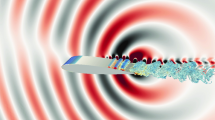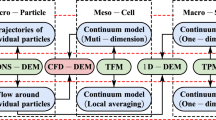Abstract
In this paper, the effects of the sub-grid scale (SGS) turbulent Schmidt number, Sc SGS, on the large eddy simulation of dispersion on and around an isolated cubical model building with a flush vent located on its roof are examined. Constant and dynamic Sc SGS approaches for SGS turbulent mass flux modeling are employed. Simulation results are compared with the available wind tunnel measurements. Furthermore, the influence of the grid resolution on the accuracy of results predicted by the dynamic Sc SGS approach is investigated. Detailed statistical analysis of Sc SGS demonstrates that the dynamically computed Sc SGS at different locations varies by a factor of almost 5 and a considerable deviation of Sc SGS from its common values of 0.5 and 0.7 occurs. Particularly, in the vicinity of the building where the concentration gradients are noticeable, Sc SGS has a larger variation. Also, the probability of occurrence of 0.2 < Sc SGS <1.5 is more than 90 percent and the Sc SGS mean values are nearly around 0.8 to 1 with a maximum variance of 0.2. In addition, by refining the grid, the differences between the predictions of constant and dynamic Sc SGS approaches decrease. This is due to the reduction of sub-grid scales contribution to turbulent dispersion. It is confirmed that dynamic Sc SGS approach is a practical alternative to the constant Sc SGS approach, effectively eliminating a user-defined model coefficient.
Similar content being viewed by others
References
Ayo SA, Mohd-Ghazali N, Mansor S (2015). Outdoor ventilation performance of various configurations of a layout of two adjacent buildings under isothermal conditions. Building Simulation, 8: 81–98.
Baggett J, Jiménez J, Kravchenko A (1997). Resolution requirements in large-eddy simulations of shear flows. Annual Research Briefs, Center for Turbulence Research, Stanford University, pp. 51–66.
Bazdidi-Tehrani F, Ghafouri A, Jadidi M (2013). Grid resolution assessment in large eddy simulation of dispersion around an isolated cubic building. Journal of Wind Engineering and Industrial Aerodynamics, 121: 1–15.
Bazdidi-Tehrani F, Jadidi M (2014). Large eddy simulation of dispersion around an isolated cubic building: Evaluation of localized dynamic kSGS equation sub-grid scale model. Environmental Fluid Mechanics, 14: 565–589.
Bazdidi-Tehrani F, Mohammadi-Ahmar A, Kiamansouri M, Jadidi M (2015). Investigation of various non-linear eddy viscosity turbulence models for simulating flow and pollutant dispersion on and around a cubical model building. Building Simulation, 8: 149–166.
Blocken B (2014). 50 years of Computational Wind Engineering: Past, present and future. Journal of Wind Engineering and Industrial Aerodynamics, 129: 69–102.
Blocken B, Abuku M, Nore K, Briggen PM, Schellen HL, Thue JV, Roels S, Carmeliet J (2011). Intercomparison of wind-driven rain deposition models based on two case studies with full-scale measurements. Journal of Wind Engineering and Industrial Aerodynamics, 99: 448–459.
Blocken B, Stathopoulos T, Carmeliet J (2007). CFD simulation of the atmospheric boundary layer: Wall function problems. Atmospheric Environment, 41: 238–252.
Blocken B, Stathopoulos T, Carmeliet J, Hensen JLM (2010). Application of computational fluid dynamics in building performance simulation for the outdoor environment: An overview. Journal of Building Performance Simulation, 4: 157–184.
Blocken B, Tominaga Y, Stathopoulos T (2013). CFD simulation of micro-scale pollutant dispersion in the built environment. Building and Environment, 64: 225–230.
Bou-Zeid E, Vercauteren N, Parlange MB, Meneveau C (2008). Scale dependence of subgrid-scale model coefficients: An a priori study. Physics of Fluids, 20: 115106.
Chavez M, Hajra B, Stathopoulos T, Bahloul A (2011). Near-field pollutant dispersion in the built environment by CFD and wind tunnel simulations. Journal of Wind Engineering and Industrial Aerodynamics, 99: 330–339.
Cheng WC, Porté- Agel F (2013). Evaluation of subgrid-scale models in large-eddy simulation of flow past a two-dimensional block. International Journal of Heat and Fluid Flow, 44: 301–311.
Cheng WC, Liu CH (2011). Large-eddy simulation of turbulent transports in urban street canyons in different thermal stabilities. Journal of Wind Engineering and Industrial Aerodynamics, 99: 434–442.
Davidson L (2011). How to estimate the resolution of an LES of recirculating flow. In: Salvetti MV, Geurts B, Meyers J, Sagaut P (eds), Quality and Reliability of Large-Eddy Simulations II. Dordrecht, the Netherlands: Springer. pp. 269–286
Davidson L (2015). Fluid Mechanics, Turbulent Flow and Turbulence Modeling. Goteborg, Sweden: Chalmers University of Technology.
Franke J, Hellsten A, Schlunzen H, Carissimo B (2011). The COST 732 Best Practice Guideline for CFD simulation of flows in the urban environment: A summary. International Journal of Environment and Pollution, 44: 419–427.
Germano M, Piomelli U, Moin P, Coboy WH (1991). A dynamic subgrid-scale eddy viscosity model. Physics of Fluids A, 3: 1769–1765.
Gousseau P, Blocken B, Stathopoulos T, van Heijst GJF (2011a). CFD simulation of near-field pollutant dispersion on a high-resolution grid: A case study by LES and RANS for a building group in downtown Montreal. Atmospheric Environment, 45: 428–438.
Gousseau P, Blocken B, van Heijst GJF (2011b). CFD simulation of pollutant dispersion around isolated buildings: On the role of convective and turbulent mass fluxes in the prediction accuracy. Journal of Hazardous Materials, 194: 422–434.
Gousseau P, Blocken B, van Heijst GJF (2012). Large-Eddy Simulation of pollutant dispersion around a cubical building: Analysis of the turbulent mass transport mechanism by unsteady concentration and velocity statistics. Environmental Pollution, 167: 47–57.
Gousseau P, Blocken B, van Heijst GJF (2013). Quality assessment of Large-Eddy Simulation of wind flow around a high-rise building: Validation and solution verification. Computers & Fluids, 79: 120–133.
Hinze JO (1975). Turbulence. New York: McGraw-Hill.
Iizuka S, Kondo H (2004). Performance of various sub-grid scale models in large-eddy simulations of turbulent flow over complex terrain. Atmospheric Environment, 38: 7083–7091.
Jiang G, Yoshie R, Shirasawa T, Jin X (2012). Inflow turbulence generation for large eddy simulation in non-isothermal boundary layers. Journal of Wind Engineering and Industrial Aerodynamics, 104–106: 369–378.
Kim W-W, Menon S (1997). Application of the localized dynamic subgrid-scale model to turbulent wall-bounded flows. Technical Report AIAA-97-0210. In: Proceedings of 35th Aerospace Sciences Meeting, Reno, USA.
Kleissl J, Meneveau C, Parlange MB (2003). On the magnitude and variability of subgrid-scale eddy-diffusion coefficients in the atmospheric surface layer. Journal of the Atmospheric Sciences, 60: 2372–2388.
Köse DA, Fauconnier D, Dick E (2011). ILES of flow over low-rise buildings: Influence of inflow conditions on the quality of the mean pressure distribution prediction. Journal of Wind Engineering and Industrial Aerodynamics, 99: 1056–1068.
Lateb M, Masson C, Stathopoulos T, Bédard C (2010). Numerical simulation of pollutant dispersion around a building complex. Building and Environment, 45: 1788–1798.
Li WW, Meroney RN (1983). Gas dispersion near a cubical model building. Part I. Mean concentration measurements. Journal of Wind Engineering and Industrial Aerodynamics, 12: 15–33.
Lilly DK (1967). The representation of small scale turbulence in numerical simulation experiments. In: Proceedings of IBM Scientific Computing Symposium on Environmental Sciences, pp. 195–210.
Lilly DK (1992). A proposed modification of the Germano subgrid-scale closure method. Physics of Fluids A, 4: 633–635.
Liu X, Niu J, Kwok KC (2013). Evaluation of RANS turbulence models for simulating wind-induced mean pressures and dispersions around a complex-shaped high-rise building. Building Simulation, 6: 151–164.
Manhart M, Wengle H (1993). A spatiotemporal decomposition of a fully inhomogeneous turbulent flow field. Theoretical and Computational Fluid Dynamics, 5: 223–242.
Mason PJ, Derbyshire SH (1990). Large-eddy simulation of the stablystratified atmospheric boundary layer. Boundary-Layer Meteorology, 53: 117–162.
Mathey F, Cokljat D, Bertoglio JP, Sergent E (2006). Assessment of the vortex method for Large Eddy Simulation inlet conditions. Progress in Computational Fluid Dynamics, 6: 58–67.
Meneveau C, Katz J (2000). Scale-invariance and turbulence models for large-eddy simulation. Annual Review of Fluid Mechanics, 32: 1–32.
Menter F (2012). Best Practice: Scale-Resolving Simulations in ANSYS CFD. ANSYS Inc.
Moin P, Squires K, Cabot W, Lee S (1991). A dynamic subgrid-scale model for compressible turbulence and scalar transport. Physics of Fluids A, 3: 2746–2757.
Murakami S (1998). Overview of turbulence models applied in CWE–1997. Journal of Wind Engineering and Industrial Aerodynamics, 74: 1–24.
Murakami S, Iizuka S, Ooka R (1999). CFD analysis of turbulent flow past square cylinder using dynamic LES. Journal of Fluids and Structures, 13: 1097–1112.
OpenFOAM (2014). OpenFOAM 2.3.1 User Guide. Available at http://www.openfoam.com/.
Pope SB (2000). Turbulent Flows. Cambridge, UK: Cambridge University Press.
Pope SB (2004). Ten questions concerning the large-eddy simulation of turbulent flows. New journal of Physics, 6: 35.
Porté-Agel F, Pahlow M, Meneveau C, Parlange MB (2001). Atmospheric stability effect on subgrid-scale physics for large-eddy simulation. Advances in Water Resources, 24: 1085–1102.
Porté-Agel F, Wu Y-T, Lu H, Conzemius RJ (2011). Large-eddy simulation of atmospheric boundary layer flow through wind turbines and wind farms. Journal of Wind Engineering and Industrial Aerodynamics, 99: 154–168.
Rahmatmand A, Yaghoubi M, Rad EG, Tavakol MM (2014). 3D experimental and numerical analysis of wind flow around domed-roof buildings with open and closed apertures. Building Simulation, 7: 305–319.
Shen H, He Q, Liu Y, Zhang Y, Dong B (2014). A passive scalar subgrid scale model and its application to airflow simulation around a building. Building Simulation, 7: 147–154.
Stoll R, Porté-Agel F (2006). Dynamic subgrid-scale models for momentum and scalar fluxes in large-eddy simulations of neutrally stratified atmospheric boundary layers over heterogeneous terrain. Water Resources Research, 42: W01409.
Tominaga Y, Murakami S, Mochida A (1997). CFD prediction of gaseous diffusion around a cubic model using a dynamic mixed SGS model based on composite grid technique. Journal of Wind Engineering and Industrial Aerodynamics, 67: 827–841.
Tominaga Y, Mochida A, Murakami S, Sawaki S (2008a). Comparison of various revised k–e models and LES applied to flow around a high-rise building model with 1:1:2 shape placed within the surface boundary layer. Journal of Wind Engineering and Industrial Aerodynamics, 96: 389–411.
Tominaga Y, Mochida A, Yoshie R, Kataoka H, Nozu T, Yoshikawa M, Shirasawa T (2008b). AIJ guidelines for practical applications of CFD to pedestrian wind environment around buildings. Journal of Wind Engineering and Industrial Aerodynamics, 96: 1749–1761.
Tominaga Y, Stathopoulos T (2010). Numerical simulation of dispersion around an isolated cubic building: Model evaluation of RANS and LES. Building and Environment, 45: 2231–2239.
Tominaga Y, Stathopoulos T (2011). CFD modeling of pollution dispersion in a street canyon: Comparison between LES and RANS. Journal of Wind Engineering and Industrial Aerodynamics, 99: 340–348.
Tominaga Y, Stathopoulos T (2012). CFD modeling of pollution dispersion in building array: Evaluation of turbulent scalar flux modeling in RANS model using LES results. Journal of Wind Engineering and Industrial Aerodynamics, 104–106: 484–491.
Tominaga Y, Stathopoulos T (2013). CFD simulation of near-field pollutant dispersion in the urban environment: A review of current modeling techniques. Atmospheric Environment, 79: 716–730.
Versteeg HK, Malalasekera W (2007). An Introduction to Computational Fluid Dynamics: The Finite Volume Method. Harlow, UK: Pearson Education.
Werner H, Wengle H (1993). Large-eddy simulation of turbulent flow over and around a cube in a plate channel. In: Durst FRF, Launder B, Schmidt F, Schumann U, Whitelaw J (eds), Turbulent Shear Flows 8. Munich: Springer. pp. 155–168
Yoshie R, Jiang G, Shirasawa T, Chung J (2011). CFD simulations of gas dispersion around high-rise building in non-isothermal boundary layer. Journal of Wind Engineering and Industrial Aerodynamics, 99: 279–288.
Author information
Authors and Affiliations
Corresponding author
Rights and permissions
About this article
Cite this article
Jadidi, M., Bazdidi-Tehrani, F. & Kiamansouri, M. Dynamic sub-grid scale turbulent Schmidt number approach in large eddy simulation of dispersion around an isolated cubical building. Build. Simul. 9, 183–200 (2016). https://doi.org/10.1007/s12273-015-0257-0
Received:
Revised:
Accepted:
Published:
Issue Date:
DOI: https://doi.org/10.1007/s12273-015-0257-0




